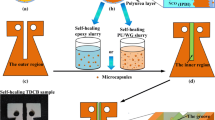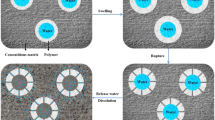Abstract
Urea formaldehyde/epoxy resin microcapsules were prepared by an in situ polymerization method and the effect of emulsifier on the syntheses process of the microcapsules was discussed. The surface morphology of the microcapsules was observed by optical microscopy and scanning electron microscopy (SEM). Chemical structure was characterized by Fourier transform infrared spectroscopy (FTIR). Thermal stability was obtained using simultaneous thermal analysis (STA). The microcapsules were composed of urea-formaldehyde resin shell and epoxy resin core. Emulsifier played an important role in the polymerization process when the core material was packed by pre-polymer, so the effects of different emulsifiers (OP-10, SDS and SDBS) were discussed respectively. Results showed that the particle size of the microcapsules was uniform when SDBS as an emulsifier. Microcapsules showed good thermal stability below 240 °C and the initial decomposition temperature of the microcapsules was 265 °C. The core materials released after microcapsules rupturing, which could be proven by the images of SEM. When implanted in cementitious composites, complete shape of microcapsules and good interface between microcapsules and cement specimen substrate could also be observed.
Similar content being viewed by others
References
Li V C, Lim Y M, Chan Y W. Feasibility Study of a Passive Smart Self-Healing Cementitious Composite[J]. Chan, Compos. Part. B-Eng., 1998, 29(6): 819–827
Muynck W De, Cox K, Belle N De, et al. Bacterial Carbonate Precipitation as an Alternative Surface Treatment for Concrete[J]. Constr. Build. Mater., 2008, 22(5): 875–885
Yang Y Z, Lepech M D, Yang E H, et al. Autogenous Healing of Engineered Cementitious Composites under Wet-Dry Cycles[J]. Cem. Concr. Res., 2009, 39(5): 382–390
Yang Y Z, Yang E H, Li V C. Autogenous Healing of Engineered Cementitious Composites at Early Age[J]. Cem. Concr. Compos., 2011, 41(2): 176–183
Yang Z X, Hollar J, He X D, et al. A Self-Healing Cementitious Composite Using Oil Core/Silica Gel Shell Microcapsules[J]. Cem. Concr. Compos., 2011, 33(4): 506–512
Li V C, Herbert E. Robust Self-Healing Concrete for Sustainable Infrastructure[J]. J. Adv. Concr. Technol., 2012, 10(6): 207–218
Gao L X, Sun G W. Development of Microbial Technique in Self-Healing of Concrete Cracks[J]. J. Chin. Chem. Soc., 2013, (05): 627–636
Jiang Z W, Li W T, Yuan Z Z. Self-Healing of Cracks in Concrete with Various Crystalline Mineral Additives in Underground Environment[J]. J. Wuhan Univ. Technol. -Mater. Sci. Ed., 2014, 29(5): 938–944
Kirk J G, Naik S, Moosbrugger J C, et al. Self-Healing Epoxy Composites Based on the Use of Nanoporous Silica Capsules[J]. Int. J. Fract., 2009, 159(1): 101–102
Dong B Q, Wang Y S, Fang G H, et al. Smart Releasing Behavior of a Chemical Self-Healing Microcapsule in the Stimulated Concrete Pore Solution[J]. Cem. Concr. Compos., 2015, 56: 46–50
Nesterova T, Dam-Johansen K, Kiil S. Synthesis of Durable Microcapsules for Self-Healing Anticorrosive Coatings: A Comparison of Selected Methods[J]. Prog. Org. Coat., 2011, 70(4): 342–352
Ma A J, Zhang Q Y, Zhang H P, et al. Preparation of Vinyl Silicone Oil Microcapsules with Self-Healing Functions[J]. Paint Coat. Ind., 2013 (08): 24–27
Tong X M, Zhang M, Chen F, et al. Study on the Preparation Technics of Epoxy Resins Coated Polystyren Self-Repair Microcapsules[J]. J. Shaanxi Univ. Sci. Technol., 2008, (05): 43–46
Zhu M H. Study on Preparation and Performance of Microcapsule Composite Materials for Self-Healing[D]. Harbin: Harbin Inst. Technol., 2012
Zhao J X, Li H Y. Study on Preparation of Self-healing Microcapsules Applied in the Pavement Materials[J]. Appl. Chem. Ind., 2013(03): 389–391
Tan N P B, Keung L H, Choi W H, et al. Silica-based Self-Healing Microcapsules for Self-Repair in Concrete[J]. J. Appl. Polym. Sci., 2016, 133(12); DOI: 10.1002/App.43090
Author information
Authors and Affiliations
Corresponding author
Additional information
Funded by State Key Laboratory of Silicate Materials for Architectures (No.SYSJJ2016-07), Wuhan University of Technology
Rights and permissions
About this article
Cite this article
Mao, Q., Feng, X., Liang, P. et al. Characteristics of Self-Healing Microcapsules for Cementitious Composites. J. Wuhan Univ. Technol.-Mat. Sci. Edit. 33, 1108–1112 (2018). https://doi.org/10.1007/s11595-018-1942-5
Received:
Accepted:
Published:
Issue Date:
DOI: https://doi.org/10.1007/s11595-018-1942-5




